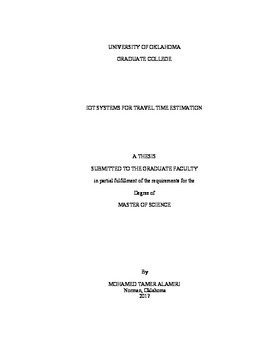| dc.contributor.advisor | Refai, Hazem | |
| dc.contributor.author | alamiri, Mohamed tamer | |
| dc.date.accessioned | 2018-01-26T16:03:20Z | |
| dc.date.available | 2018-01-26T16:03:20Z | |
| dc.date.issued | 2017-12-20 | |
| dc.identifier.uri | https://hdl.handle.net/11244/54319 | |
| dc.description.abstract | This research introduces new approach for vehicle re-identification by computing Relative Entropy and Pearson correlation between ILD signatures, and then estimating TT based on the highest correlated signatures. To clear measure noise, TT for vehicles is assumed to follow the same pattern within a certain time frame. Thus, TT values are arranged in time series groups before applying a spike detection algorithm to determine the TT range with the highest number of vehicles. A data spike is considered for estimating TT. Given that the number of vehicles within the spike is greater than number of vehicles in all other data groups, TT will be the mean value of TT within the spike. | en_US |
| dc.language | en_US | en_US |
| dc.subject | Travel Time Estimation, Intelligent Transportation Systems, Signal Processing, Inductive Loops Detectors | en_US |
| dc.title | IOT SYSTEMS FOR TRAVEL TIME ESTIMATION | en_US |
| dc.contributor.committeeMember | Runolfsson, Thordur | |
| dc.contributor.committeeMember | Chan, Kam Wai C | |
| dc.date.manuscript | 2017-12-20 | |
| dc.thesis.degree | Master of Science | en_US |
| ou.group | College of Engineering::School of Electrical and Computer Engineering | en_US |
